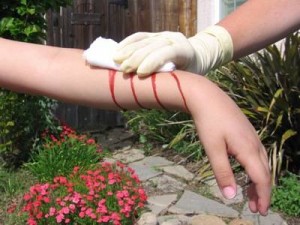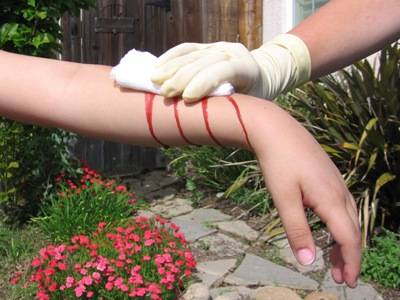Severe bleeding refers to the heavy blood flow that results in a lot of blood being lost from the body. Severe bleeding may be caused by the body’s natural openings such as the mouth and the nose, or due to external cuts caused by injury or trauma. Internal bleeding occurs due to physical trauma in which the blood vessels are damaged without perforating the skin.

Causes
- Falls, accidents, assaults
- Blows to the head
- Tooth extraction
- Medication
- Illnesses: Hemophilia, cancer, scurvy, anemia, leukemia, thrombocytopenia, hemorrhage, liver disease, septicemia, platelet disorder
Symptoms
- Heavy bleeding
- Vomiting blood
- Blood discharge from natural openings of the body
- Bloody stool or urine
- Bruising
- Darkening of the skin in case of internal bleeding injuries
Internal bleeding
If you see signs of internal bleeding, contact emergency medical help promptly. Signs and symptoms of internal bleeding include:
- Bleeding from natural openings
- Cool skin
- Darkening of the skin
- Vomiting blood
- Coughing out blood
- Fractures
- Bruising on the abdominal region and the neck or chest region
- Injuries that have radiated towards the skill, chest or abdominal regions
- Weakness and anxiety
- Shock
Treatment
Before you begin self-treatment, make sure you wash your hands with soap and water to prevent infection. Wear gloves, if you have any with you. In case the wound is in the abdominal region or has displaced any organs, do not try to recover the injury yourself by trying to push the organs back to their original positions. Simply, cover the injury with a sterile dressing.
Follow the given instructions below, in case of heavy bleeding:
- Allow the casualty to lie down and cover him with a blanket so that body heat is not lost. Ensure that the person’s head is lower than the chest level and elevate the legs and injured area to encourage blood circulation.
- Remove any dirt or debris with gloves on. Do not try to remove any object embedded in your skin.
- Use a sterile bandage or clean piece of fabric to apply pressure directly on the wound for at least 20 minutes to stop bleeding. Do not continually check while applying pressure if the bleeding has stopped. Maintain this pressure by securing the wound with a tightly wound bandage and adhesive tape. If no cloth or bandage is available, it is ideal that you wear gloves while stopping the bleeding with your hands but if nothing is at your disposal, simply use your bare hands.
- If bleeding is continuous and soaks the gauze, do not remove it. Simply, add more dressing on top of the existing gauze.
- If bleeding is persistent, squeeze a main artery to discourage blood flow. You can do this by applying pressure directly on pressure points above the elbow, inside the arm and below the armpit to prevent blood discharge from an arm injury. Bleeding in case of a leg injury can be stopped by applying pressure in the genitals or behind the knee. The main arteries are present in these regions and lie against a bone. While applying pressure, flatten your fingers and apply pressure on the wound as well with your other hand.
- Once bleeding has stopped, do not remove the bandages; seek emergency medical treatment immediately.
Learn More About Treating Severe Bleeding
To learn more about this topic and emergencies take a St Mark James training course. Courses such as emergency, standard and childcare first aid cover major and minor bleeding emergencies. To find a provider near you visit our locations page. We have training partners located throughout Canada in Calgary, Edmonton, Vancouver, Ottawa, Toronto, Halifax, Regina and Winnipeg.
Related Video on Severe Bleeding


Our body has a definite blood prsseure. A drop in the said prsseure is a condition termed as hypotension, more popularly low blood prsseure. In such a condition, the heart forces the blood out of the arteries with much less strength than it should. Low blood prsseure is an outcome of weakened and devitalized system. Some of the main causes of low blood prsseure are faulty nutrition or malnutrition, emotional instability, loss of blood and slow internal bleeding. Lethargy, weakness, fatigue and dizziness are the most common symptoms of low blood prsseure. A person might even faint, if the arterial prsseure gets extremely low. Low blood prsseure can, however, be treated naturally, using some home remedies. Read on to know how to cure low blood prsseure, at home.Home Remedy For Low Blood Pressure * The best and the most effective home remedy for treating low blood prsseure would be to consume lots of water. This is because dehydration reduces blood volume and leads to a drop in the blood prsseure. * Beetroot juice is beneficial for those suffering from low blood prsseure. So, have a cup of raw beetroot juice two times a day. * Prepare a cup of strong black coffee and consume this whenever you feel that your blood prsseure is dipping. * Put 15-20 gm of Indian Spikenard in 250 ml water and boil it. Now, remove from heat and let it cool down. Have this infusion thrice a day. You can also have 30-40 grains of Indian Spikenard, along with some camphor and cinnamon. * Fill your bathtub with lukewarm water and add one kg of Epsom salt to it. Immerse yourself in the bath for 20 minutes, before going to bed. Take caution not to expose the body to a cold area after this. * In a bowl of water, soak 7 almonds and keep them overnight. Peel them and prepare a paste. Add this paste to lukewarm milk and drink it. * Take a bowl of water and soak 30 raisins in it, overnight. Chew them one by one, on an empty stomach, in the morning and have water. * Holy basil works effectively in curing low blood prsseure. Take about 15 holy basil leaves and crush them. Filter the mixture with the help of a muslin cloth. Have this filtered mixture, along with a tsp of honey, on an empty stomach. * Include salt, asafoetida and fruits in your diet. All these are beneficial in restoring the blood prsseure level. * Foods rich in proteins, vitamin C and vitamin B are effective in treating low blood prsseure. * Exercises, light walking, swimming and cycling are beneficial in regulating the blood prsseure level. Was this answer helpful?